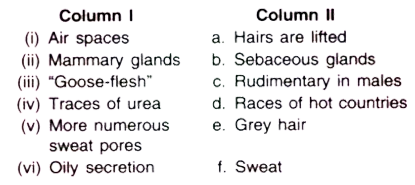Match items in Column - I with those in Column - II
Column -IColumn -IIa.Peritrichous flagellation(i)Ginkgob.Living fossil(ii)Macrocystesc.Rhizophore(iii)Esherichia coild.Smallest flowering plant(iv)Selaginellae.Largest pernnial alga(v)Wolffia
Select the correct answer from the following :
a (ii) , b (i) , c (ii) , d (iv) , e (v)
a (v) , b (iii) , c (ii) , d (v) , e (i)
a (i) , b (iii) , c (v) , d (iii) , e (ii)
a (iii) , b (i) , c (iv) , d (v) , e (ii)
The correct Answer is:D
To solve the matching question between Column - I and Column - II, we will analyze each term in Column - I and find its corresponding match in Column - II.
1. Peritrichous flagellation:
- Peritrichous flagellation refers to a type of flagellation where multiple flagella are present all over the body of the organism.
- This type of flagellation is commonly found in Escherichia coli.
- Match: (a) Peritrichous flagellation → (iii) Escherichia coli
2. Living fossil:
- A living fossil is a species that has remained relatively unchanged over a long period and provides insight into the past.
- The most well-known example of a living fossil is Ginkgo.
- Match: (b) Living fossil → (i) Ginkgo
3. Rhizophore:
- A rhizophore is a leafless cylindrical organ that is found in certain plants.
- It is specifically associated with Selaginella.
- Match: (c) Rhizophore → (iv) Selaginella
4. Smallest flowering plant:
- The smallest flowering plant is known as Wolffia.
- Match: (d) Smallest flowering plant → (v) Wolffia
5. Largest perennial alga:
- The largest perennial alga is known as Macrocystis.
- Match: (e) Largest perennial alga → (ii) Macrocystis
Final Matches:
- (a) Peritrichous flagellation → (iii) Escherichia coli
- (b) Living fossil → (i) Ginkgo
- (c) Rhizophore → (iv) Selaginella
- (d) Smallest flowering plant → (v) Wolffia
- (e) Largest perennial alga → (ii) Macrocystis
Summary of the Correct Answer:
- A-3
- B-1
- C-4
- D-5
- E-2
- Peritrichous flagellation refers to a type of flagellation where multiple flagella are present all over the body of the organism.
- This type of flagellation is commonly found in Escherichia coli.
- Match: (a) Peritrichous flagellation → (iii) Escherichia coli
- A living fossil is a species that has remained relatively unchanged over a long period and provides insight into the past.
- The most well-known example of a living fossil is Ginkgo.
- Match: (b) Living fossil → (i) Ginkgo
- A rhizophore is a leafless cylindrical organ that is found in certain plants.
- It is specifically associated with Selaginella.
- Match: (c) Rhizophore → (iv) Selaginella
- The smallest flowering plant is known as Wolffia.
- Match: (d) Smallest flowering plant → (v) Wolffia
- The largest perennial alga is known as Macrocystis.
- Match: (e) Largest perennial alga → (ii) Macrocystis
- (a) Peritrichous flagellation → (iii) Escherichia coli
- (b) Living fossil → (i) Ginkgo
- (c) Rhizophore → (iv) Selaginella
- (d) Smallest flowering plant → (v) Wolffia
- (e) Largest perennial alga → (ii) Macrocystis
- A-3
- B-1
- C-4
- D-5
- E-2
Topper's Solved these Questions
- PLANT KINGDOM BOOK - AAKASH INSTITUTE ENGLISHCHAPTER - PLANT KINGDOM EXERCISE - ASSIGNMENT SECTION -D (Assertion - Reason Type Questions)
10 Videos
- PLANT KINGDOM BOOK - AAKASH INSTITUTE ENGLISHCHAPTER - PLANT KINGDOM EXERCISE - ASSIGNMENT SECTION -B (Objective Type Questions)
35 Videos
- PLANT GROWTH AND DEVELOPMENTBOOK - AAKASH INSTITUTE ENGLISHCHAPTER - PLANT GROWTH AND DEVELOPMENTEXERCISE - ASSIGNMENT (SECTION -D)
10 Videos
- PRINCIPLES OF INHERITANCE AND VARIATIONBOOK - AAKASH INSTITUTE ENGLISHCHAPTER - PRINCIPLES OF INHERITANCE AND VARIATIONEXERCISE - Assignment (SECTION-D) Assertion-Reason Type Questions
20 Videos
Similar Questions
Match the items in Column I with those in Column II

View SolutionMatch the items of Column-I with those in Column-II

View SolutionMatch the items of Column-I with those in Column-II

View SolutionMatch the items of Column-I with those in Column-II

View SolutionMatch the items of Column-I with those in Column-II

View SolutionMatch the items of Column-I with those in Column-II

View SolutionMatch the items of Column I with those of Column II.

View SolutionMatch the items in column I with those given in column II.

View SolutionMatch the items of Column I with items of Column II.

View SolutionMatch the items of Column I with items of Column II.

View Solution
